Skip to: Somalia | Central African Republic | Tuberculosis | Chechnya | Sri Lanka | Malnutrition | Democratic Republic of Congo | Colombia | Haiti | Central India
Somalis Trapped by War and Disaster
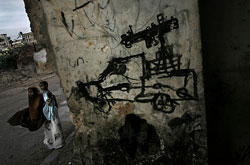
A mother and child walk past graffiti depicting the militias that roam Somalia’s capital, Mogadishu. Somalia, 2006 © Jehad Nga
The current conflict in Somalia may generate fleeting worldwide attention, but the abysmal day-to-day living conditions faced by Somalis remains largely forgotten. For the past fifteen years, Somalia has been in the grip of internal conflict that has had catastrophic consequences on the health of its people. Somalia has some of the world's worst health indicators: it is estimated that life expectancy is 47 years and more than one quarter of children die before their fifth birthday. The conflict in 2006 was characterized by intense bursts of violence in the capital, Mogadishu, and outlying regions. In July, a coalition under the umbrella of the Islamic Courts wrested control of Mogadishu from the militias that had preyed on the local population for years, and quickly gained influence in the country's central and southern areas. Then in late December, the Western- and Ethiopian-backed Transitional National Government drove the Islamic Courts from areas they controlled. Against this backdrop of political insecurity, Somalia was hit by torrential rains in November that flooded the Shebelle and Juba rivers, leaving tens of thousands of families homeless and destroying their subsistence crops. This occurred just six months after the Bay region, nestled between the two rivers, endured a drought that saw MSF admit more than 600 severely malnourished children to its hospital in Dinsor. MSF teams are trying to fill some of the huge gaps in medical care through primary care and surgical hospitals and clinics, as well as treatment programs for malnutrition, tuberculosis, and kala azar in several regions, including Bakool, Bay, Galguduud, Lower Juba, Mudug, Middle Shabelle, and Mogadishu. Few aid agencies choose to work in Somalia, though, because violence is so widespread and the country's clan structure so complex. But with no state medical services, there is a desperate need for increased assistance.

Fleeing Violence in the Central African Republic (CAR)
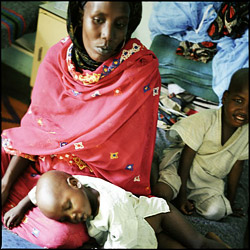
Around 30,000 people who fled violence in northern Central African Republic are living in three refugee camps around the little village of Goré in southern Chad. Chad, 2006 © Philip Horak
In 2006, civilians in the Central African Republic (CAR) once again fell victim to horrific violence in the latest bout of conflict in a string of coups and rebellions that have plagued the country since it achieved independence from France in 1960. And once more, the plight of the country's 3.6 million people went largely unnoticed. Since November 2005, fighting has occurred between government troops and various rebel groups in the country's northwest. Civilians suspected of supporting one side or the other, are targeted or caught in the crossfire. Many villages along the roads have been attacked, looted, or burnt. An estimated 100,000 civilians were forced to flee their homes, with some fleeing to neighboring Chad — where MSF is providing assistance — while others sought refuge in the country's forests, exposed to harsh elements and lacking adequate shelter, food, clean water, and health care.
MSF started working in northwest CAR in November 2005 and steadily increased activities throughout 2006, providing primary and secondary health care in and around Kabo, Batangafo, Paoua, Markounda, and Boguila to people who had no access to basic health services. In 2006, MSF performed more than 200 surgical interventions every month. Several MSF mobile teams in the area provided medical care to people who had fled to the forests, carrying out an average of 1,800 consultations per week. The patients, many of whom are children under five, mostly suffer from malaria, worm infestation, or acute respiratory infections . In fall 2006, resurgence of violence around Paoua, Markounda, and Kabo forced many people to hide in the forests yet again. At the end of October, the rebel group Union des Forces Démocratiques pour le Rassemblement (UFDR) launched an attack in northeast CAR and seized control of Birao, Ouanda Djallé, and several other cities. Civilians remained cut off from aid when authorities refused MSF and other humanitarian organizations access to the region. After government forces had regained control in December, MSF teams were eventually allowed to assess the needs.

Increasing Human Toll Taken by Tuberculosis
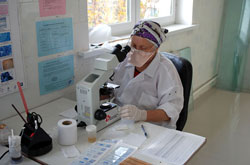
Every year, TB kills nearly two million people while an estimated nine million develop the disease. An additional 450,000 new cases of multidrug-resistant (MDR) TB are seen every year. Kyrgyzstan, 2006 © Claude Mahoudeau/MSF
While many people in the West consider tuberculosis (TB) a disease of a bygone era, the devastating human toll taken by the disease is increasing worldwide, particularly in developing countries with high HIV prevalence. Every year, TB kills nearly 2 million people while an estimated 9 million develop the disease. An additional 450,000 new cases of multidrug-resistant (MDR) TB are seen every year. This frightening situation became even worse in 2006 when a survey among 544 TB patients in Kwazulu Natal, South Africa, found 10percent had developed XDR TB, a strain of TB that is resistant to both first-line antibiotics as well as to two classes of second-line drugs. Almost all of these patients died, and the extent of the outbreak remains unknown.
Even so, the drugs in today's standard TB treatment were developed in the 1950s and 1960s, while the most commonly used TB test — sputum microscopy — was developed in 1882 and only detects TB in half of the cases. Existing TB treatments and diagnostics are even less adapted for use in people living with HIV/AIDS, even though TB is their number one killer. The years of neglect are underscored by the fact that of the 1,556 new chemical entities marketed worldwide between 1975 and 2004, only 3 were for TB. Even though some initiatives are underway, efforts need to be significantly increased in order to respond to the disastrous impact of TB. None of the drugs currently in development, however promising, will be able to drastically improve TB treatment in the near future. "That TB destroys millions of lives around the world every year shows that the current approach is just not working," said Dr. Tido von Schoen-Angerer, Director of MSF's Campaign for the Access to Essential Medicines. "The tools we have to treat and diagnose TB are woefully inadequate and outdated, and we're not seeing the necessary urgency to tackle the disease."

Consequences of Bitter Conflict in Chechnya
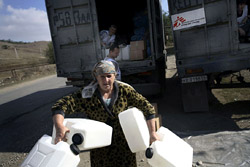
In a village near Chechnya’s capital, Grozny, a woman receives a distribution of relief items from MSF. The majority of Chechens displaced to neighboring Ingushetia during the worst phases of the conflict have now returned home, but thousands still find themselves living in miserable conditions in temporary accommodation centers. Chechnya, 2006 © Misha Galustov/agency.photographer.ru
The conflict in Chechnya and its consequences on civilians has been almost entirely hidden from the rest of the world. While it may be decreasing in intensity, for many people who lived through the ebb and flow of this bitter twelve-year war, physical and mental scars remain. The majority of Chechens displaced to neighboring Ingushetia during the worst phases of the conflict have now returned home. Even though reconstruction has gathered pace in the capital, Grozny, and a few other towns over the past year, thousands of returnees still find themselves without homes to go back to and have to settle instead for miserable living conditions in temporary accommodation centers (TACs). The Russian government has promoted a policy where local Chechen authorities take increasing responsibility for security, yet violence, abductions, and abuses continue. The past year also saw an increase in violence in the neighboring republics of Ingushetia and Dagestan, but international aid workers, observers, and journalists still have limited access to the region. MSF continues to provide much needed medical and psychosocial care to the most vulnerable Chechens, both in the TACs and in impoverished rural areas where the local health infrastructure is nearly absent. Another evident casualty of the years of conflict has been the republic's TB control system, and MSF now supports four of the five existing TB facilities. In 2006, MSF introduced a reconstructive surgery program in Grozny, deploying maxillofacial, vascular, and trauma surgeons to help repair physical scars caused by the war.

Civilians Under Fire in Sri Lanka While Assistance is Limited
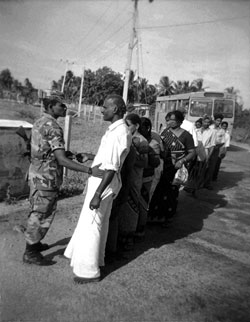
Civilians in Sri Lanka have borne the brunt of major fighting that resumed in August 2006 between government forces and the Liberation Tigers of Tamil Eelam (LTTE), especially in the country's east and northeast. Sri Lanka, 2006 © Q Sakamati
Civilians in Sri Lanka have born the brunt of major fighting that resumed in August 2006 between government forces and the Liberation Tigers of Tamil Eelam (LTTE), especially in the country's east and northeast. Bombing has been intense in war-affected regions, leading to the displacement of tens of thousands of people. Others are trapped and cannot flee. The level of violence directed at civilians has increased — a brutal reality that was underscored by the murders of 17 aid workers from Action Contre la Faim (ACF) in early August. These killings occurred in a general climate of suspicion, accusations, restrictions, and surveillance of NGOs, with Sri Lankan politicians and media outlets accusing international organizations of supporting the Tamil rebellion. As a result, some authorities have tried to evict or restrict humanitarian organizations from accessing conflict areas even as hospitals that fall under the Ministry of Health had requested outside help. As in any armed conflict, warring parties must respect the independence and neutrality of humanitarian aid workers if civilians are to receive lifesaving emergency assistance. After having to evacuate in October, MSF was again able to provide surgical care to people in the northeastern town of Point Pedro by the end of December. But insecurity and limitations placed on humanitarian organizations continue to make it increasingly difficult to deliver aid to people most affected by the conflict and several regions, particularly in the east, are entirely cut off from outside assistance.

Effective Strategies for Treating Malnutrition Not Implemented
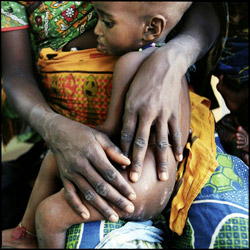
At any given moment, more than 60 million young children in the world have signs of acute malnutrition and are at serious risk of death unless they receive specialized care. But ready-to-use therapeutic foods and outpatient treatment strategies now allow many more acutely malnourished children to be treated than ever before. Chad, 2006 © Philip Horak
Every year, acute malnutrition is implicated in the preventable deaths of millions of children worldwide. At any given moment, more than 60 million young children in the world have signs of acute malnutrition — characterized by sudden weight loss or wasting — and are at serious risk of death unless they receive specialized care. Nutritional emergencies are usually thought to be associated only with conflict and displacement, but acute malnutrition is highly prevalent in politically stable countries wracked by poverty. In these contexts, the insistence on trying to address long-term development issues has come at the expense of meeting immediate needs. Services to treat even the severest forms of acute malnutrition are generally unavailable outside large humanitarian emergencies. Moreover, during such emergencies, the number of patients frequently overwhelms inpatient feeding centers. Recent strategies, though, to treat large numbers of malnourished children who have no other medical complications in their homes with relatively new ready-to-use therapeutic products (RUTF), like the milk and peanut-butter paste Plumpy'nut, offer important new promise. The energy-dense, nutrient-rich products are ideal for rapid weight gain in malnourished children with poor appetites and small stomachs, and the outpatient strategies allow for the treatment of large numbers of children. In the past two years in the impoverished central African nation of Niger, this outpatient treatment that relies on RUTFs has allowed MSF to successfully treat more than 150,000 children for moderate and severe acute malnutrition. Such products and strategies can be adapted and implemented through national health services elsewhere but are not. While continued efforts to address the underlying causes of malnutrition are critical, it is possible today to offer simple and effective curative treatment to tens of millions of children facing a high risk of death.

Congolese Endure Extreme Deprivation and Violence
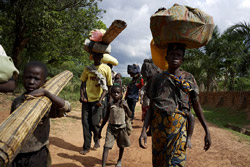
Having fled violence in the Democratic Republic of Congo’s Katanga province, thousands of displaced arrive on foot in the town of Dubie. © Per-Anders Pettersson/Getty Images
In 2006, people living in the vast Democratic Republic of Congo (DRC) voted in democratic parliamentary and presidential elections for the first time in decades. The elections may have thrust the DRC into the media spotlight for a brief moment, but the extreme deprivation and violence endured by millions of Congolese continued unabated and out of view. The mineral rich east of the country remains gripped by violence, with various armed groups, including the national army, using force against the civilian population and creating brutal living conditions. In early 2006, fighting between the Congolese army and the Mai Mai rebel forces in southeastern Katanga province were responsible for the displacement of tens of thousands of people. People forced to live in overcrowded conditions in and around the town of Dubie had virtually no access to their fields for cultivation or to clean water. With little assistance arriving, they fall prey to hunger and disease. There are also alarmingly high rates of sexual violence against women in the eastern province of North Kivu — from January to June alone, MSF treated nearly 150 women every month in three clinics across. In the northeastern Ituri district, ongoing fighting involving the Congolese army, supported by the UN peacekeeping force MONUC, and various militias has led to the destruction of numerous villages, violence against civilians, and significant displacement. In June, 50,000 displaced people sought safety in Gety, a town of 5,000 people 60 kilometers south of the district capital Bunia. After fleeing their destroyed villages and spending weeks or months in the forest, they arrived in a terrible physical state, with MSF treating hundreds of severely malnourished children just after opening its assistance program. MSF repeatedly responds to outbreaks of meningitis, malaria, cholera, and measles throughout the country, indicating how an already weak public health system has been shattered by more than a decade of war. The consequences are even seen in some areas not affected by current fighting: MSF recently began supporting a hospital in Maniema province, where the mortality rate was nearly three times the emergency threshold.

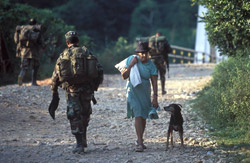
Colombia is now in its fifth decade of violent conflict. To date, almost three million people inside Colombia have fled their homes as the result of a conflict fueled by the narcotics trade that involves government military forces, paramilitary groups, and armed guerrillas from ELN and FARC. Colombia, 2005 © Jesus Abad Colorado
Colombia is now in its fifth decade of violent conflict, and only Sudan has more internally displaced people. Massacres, executions, intimidation, and fear remain inescapable parts of everyday life for civilians living in conflict-affected areas. To date, almost three million people inside Colombia have fled their homes as the result of a conflict fueled by the narcotics trade that involves government military forces, paramilitary groups, and armed guerrillas from ELN and FARC. Since 2002, President Alvaro Uribe has launched large-scale military campaigns aimed at regaining the territories occupied by rebel groups and has put government troops in more than 1,000 towns. Although most Colombians believe the security situation has markedly improved, with fewer kidnappings, less criminal activity, and safer roads, for people living in areas fought over by various armed groups, the violence and suffering has not diminished. People in these conflict zones are often cut off from basic health care services, including immunization programs, and the perception that they support the armed groups that operate locally makes it too dangerous to seek care outside their villages, even in medical emergencies. Many of the displaced have sought safety in the shantytowns springing up outside of Colombia's major cities. Once there, they endure poverty, appalling living conditions, limited access to medical and counseling services, and an ever-present risk of disease outbreaks. While physical health is an ongoing concern, mental disorders, including acute trauma caused by witnessing or being the victim of violent events, continue to go largely untreated. Through fixed and mobile clinics in the provinces of Antioquia, Bogotá, Chocó, Cordoba, Norte de Santander, Nariño, Sucre, Bolivar, and Tolima, MSF can meet only some of the vast needs brought about by Colombia's ongoing war.

Violence Rages in Haiti's Volatile Capital
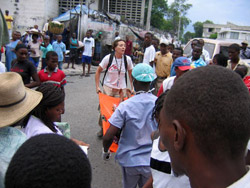
A patient is brought by ambulance to Jude Ann Hospital after delivering her child en route to the MSF-run facility. Haiti, 2006 ©Guillaume le Duc/MSF
With the exception of a short respite following presidential elections in February 2006, violence and insecurity was widespread throughout the Haitian capital, Port-au-Prince. Even with a newly elected government in place, the violence ranged from confrontations between various armed groups in the city and the Haitian National Police and UN Stabilization Mission in Haiti (MINUSTAH), to extensive kidnappings and sexual violence. The number of patients treated at four MSF medical structures in Port-au-Prince gives an indication of the human consequences of this relentless, low-intensity urban conflict. Since December 2004, MSF has treated more than 7,000 people for violence-related injuries, including more than 3,000 gunshot victims — nearly 1,000 women and children — and 2,600 stabbing victims. Following a sharp increase in violence, in early 2006 MSF called on all armed groups to respect civilians' safety and allow access to emergency medical care. In the impoverished slum of Cité Soleil, where 200,000 people are effectively cut-off from health care services, MSF continued to work in St. Catherine Hospital and Chapi health center helping victims of violence and providing maternal and primary health care services. The high level of maternal mortality in Haiti led MSF to open another health care structure in March 2006 to provide emergency obstetric care to women living in the most violent areas. The majority of the 1,200 mothers who give birth each month require emergency obstetric care. MSF also treats victims of sexual violence in the capital, offering comprehensive psychological and medical treatment.

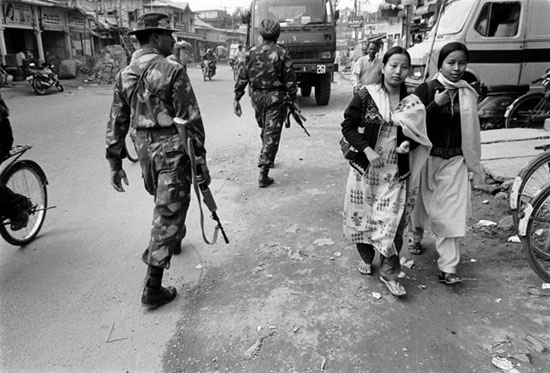
Civilians in India’s northeastern Assam and Manipur states continue to be affected by recurring outbreaks of political violence. India, 2006 © Henk Braam
Ongoing conflict in several parts of India — including northeastern Assam and Manipur states highlighted in last year's Top 10 Underreported Humanitarian Stories list — has gone virtually unnoticed by the outside world for years. In central India's Chhattisgarh state, clashes between Maoist insurgents, Indian security forces and anti-Maoist militias, also known as Salwa Judum, has been occurring for more than 25 years, resulting in the displacement, sometimes reportedly forced, of more than 50,000 civilians. Others flee into neighboring states while thousands of people have lost their livelihoods and have little access to their land, food, essential health care, or emergency medical services. MSF provides medical treatment in camps for displaced people in Dantewada district, located in south Chhattisgarh. Medical teams also provide mobile health services and nutritional support to those in need in remote rural areas. Surprisingly, the situation in Chhatisgarh is only one of several armed conflicts occurring throughout India for years, with civilians caught between various belligerent parties. As a consequence, many people continue to live in an atmosphere of fear and violence with little or no access to health care.




